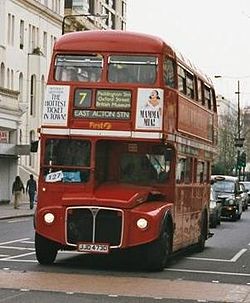Double-decker bus

A double-decker bus is a bus that has two levels. Double-decker buses are popular in Europe and in some parts of Asia, usually in ex-colonial countries. Many towns around the world have a few that specalise in short sight-seeing tours for tourists for as William Gladstone observed "the best way to see London is from the top of an omnibus".
London
The most famous bus of this type, a typical London double-decker bus, seats between 60 and 80 passengers. They are between 10.5 and 10.9 m in length and are a common reference item for describing very large objects; for example, a blue whale is about as long as three double-decker buses. They were created as a means of carrying large numbers of passengers without exceeding legal limits on vehicle length. A particularly iconic example is the Routemaster bus, which has been a staple of the public transport network in London for nearly half a century following its introduction in 1956. Citing difficulties accommodating disabled passengers, the last remaining examples in use finally retired in 2005, although Transport for London has established two "heritage routes", which will continue using Routemasters [1].
Double-decker buses are common throughout the United Kingdom and Ireland.
Other cities
Berlin
Double decker buses in Berlin are operated by Berliner Verkehrsbetriebe (BVG) and are currently 13.5 metres (44.29 feet) long and hold around 95 passengers. The proposed replacements, which will be supplied by Volvo and incorporate fuel cell technology, will be 1.8 meters (4.92 feet) longer. The new buses will be able to hold between 120 and 130 passengers.[2]
Colombo
In the 1950s, double-decker buses of the the South Western Bus Company plied on the Galle Road in Colombo, Sri Lanka. These were taken over by the Ceylon Transport Board (CTB) when all bus services were nationalised in 1958. In the 1960s, second-hand Routemaster double decker buses were imported by the CTB from London Transport and ran in their original red livery, but with the CTB logo painted on the sides. These buses were phased out beginning in the mid-1970s, but a handful still run in the Greater Colombo area. One Routemaster bus is run by the Sirasa TV and radio station. In 2005 a new batch of double decker buses were imported by the Sri Lanka Transport Board, as the reconstituted CTB is known, which run mainly on the Galle Road in Colombo.
Hong Kong

Double-decker buses were first introduced in Hong Kong in 1949 by Kowloon Motor Bus. They have become very popular since then, and they are currently found in large numbers among the fleets of the territory's major bus operators (see below). By law, double-decker buses in Hong Kong are limited to a length of 12 meters.
Mumbai
Mumbai has operated double-decker buses since 1937. They are operated by the Brihanmumbai Electric Supply and Transport Undertaking. They are modelled on the London buses.
Singapore

In October 1953, a single AEC Regent III double-decker from the fleet of General Transport Company, Kuala Lumpur (KL), was sent to Singapore for demonstration. It was used on service by the Singapore Traction Company for two weeks. After that, it was inspected by two other bus companies and then sent back to KL. However, no orders for double-deckers were to ensue at this point in time.
Singapore Bus Service (SBS, now known as SBS Transit), the current operator of double-decker buses in Singapore, launched their first double-decker bus service on 13 June 1977 with 20 Leyland Atlanteans. This time, the double-decker buses were here to stay and the fleet grew steadily, with the further introduction of the Mercedes-Benz O305 and the Leyland Olympian. The first air-conditioned double-decker bus, named the "Superbus" in recognition of its record-breaking 12m length, was launched in 1993. The first stepless, ultra low floor "Superbus" was launched in 1999. Today, SBS Transit has a fleet of over 700 double-decker buses, most of which are air-conditioned.
Victoria, British Columbia
In 2000 Victoria, British Columbia became the first city in North America to use double decker buses in its public transit system. Imported from the United Kingdom and operated by BC Transit and the Greater Victoria Transit Authority, these New Flyer buses have proven themselves to be very popular amongst both locals and tourists. The buses are mainly used on routes that go from downtown to the suburbs, including the Victoria International Airport and the BC Ferries terminal near Sidney, B.C. They can also be found on routes that head to the University of Victoria.
Las Vegas
Citizens Area Transit, the transit authority in the Las Vegas area, introduced a fleet of double-deckers to serve the Las Vegas Strip route in October 2005. The route is branded as "The Deuce".
Operators of double decker bus



- Sri Lanka Transport Board
- Kowloon Motor Bus
- China Motor Bus - company lost franchise to First Bus in 1998
- Citybus (Hong Kong)
- New World First Bus
- London Transport
- Gray Line
- Brihanmumbai Electric Supply and Transport
- SBS Transit (Singapore)
- BC Transit
